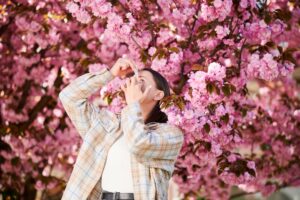How to Tell Dry Eye from Allergies
 Itchy, watery, irritated eyes are a common complaint at Riverside EyeCare Professionals—but figuring out what’s causing them isn’t always simple. Two of the most common culprits—Dry Eye Syndrome and eye allergies (allergic conjunctivitis)—can feel very similar, making it difficult to know what’s really going on. Since proper treatment depends on an accurate diagnosis, understanding the differences between these two conditions is key.
Itchy, watery, irritated eyes are a common complaint at Riverside EyeCare Professionals—but figuring out what’s causing them isn’t always simple. Two of the most common culprits—Dry Eye Syndrome and eye allergies (allergic conjunctivitis)—can feel very similar, making it difficult to know what’s really going on. Since proper treatment depends on an accurate diagnosis, understanding the differences between these two conditions is key.
Below, we’ll explain how to tell Dry Eye Syndrome from allergies, what symptoms to watch for, and when to see an eye doctor for help.
Dry Eye vs. Allergies: What’s the Difference?
While Dry Eye Syndrome and allergies can share overlapping symptoms, they stem from very different causes:
Dry Eye Syndrome occurs when your eyes don’t produce enough tears or when the tears evaporate too quickly. This eye condition can happen due to aging, environmental factors (wind, smoke, dry air), certain medications, or underlying health conditions.
Eye allergies occur when allergens—such as pollen, dust, mold, or pet dander—trigger an immune system response. The eyes release histamines, causing redness, swelling, and itching.
Since these have distinct causes, treatment approaches are very different, which makes proper identification essential.
Key Symptoms to Compare
Here’s a closer look at how to differentiate between dry eye and allergies based on symptoms:
1. Itching vs. Burning
Allergies: Itchy eyes are the hallmark symptom of allergies. If your eyes feel itchy enough to make you want to rub them constantly, allergies are likely responsible.
Dry Eye: Burning, stinging, or a gritty sensation (as if something is in your eye) is more characteristic of Dry Eye Syndrome.
2. Type of Tearing
Allergies: Allergies often cause excessive tearing as your body tries to flush out allergens.
Dry Eye: Paradoxically, dry eye can also cause watery eyes—but the tears are often poor in quality, so they don’t lubricate the eyes properly. If your eyes water but still feel dry, it’s more likely Dry Eye Syndrome.
3. Discharge
Allergies: Thick, stringy, or mucous-like discharge can accompany eye allergies.
Dry Eye: Discharge is uncommon with dry eye; instead, you might notice blurred vision that improves after blinking.
4. Other Allergy Symptoms
Allergies: Sneezing, nasal congestion, or other allergy-related symptoms often occur with allergies.
Dry Eye: Dry eye symptoms are usually isolated to the eyes.
5. Timing of Symptoms
Allergies: Symptoms often flare up during certain seasons (spring or fall) or after exposure to allergens like dust or pet hair.
Dry Eye: Symptoms may worsen in dry or windy environments, after staring at screens for long periods, or in air-conditioned or heated rooms.
How Are They Treated?
Since these two conditions have different underlying causes, the treatment options differ as well.
Dry Eye Treatment
The good news is that dry eye can often be managed effectively with the right care. At Riverside EyeCare Professionals, we offer several treatments depending on severity:
- Artificial Tears & Lubricating Eye Drops – Help replenish moisture and relieve irritation.
- Prescription Eye Drops – Can reduce inflammation and improve tear production.
- Punctal Plugs – Tiny plugs inserted into tear ducts to keep moisture on the eye’s surface longer.
- OptiLight – A non-invasive, Intense Pulsed Light (IPL) treatment that reduces inflammation, improves meibomian gland function, and supports healthier tear production.
- LipiFlow – A specialized in-office procedure that gently massages and warms the eyelids to unclog blocked meibomian glands, improving tear quality.
- Lifestyle Adjustments – Using a humidifier, taking breaks from digital screens, and staying hydrated can also help.
Allergy Treatment
If allergies are to blame, treatment generally focuses on reducing allergen exposure and calming the immune response:
- Antihistamine or Anti-Allergy Eye Drops – Reduce itching, redness, and swelling.
- Cold Compresses – Help soothe irritation and swelling.
- Avoiding Allergens – Staying indoors during high-pollen days, using air purifiers, and keeping windows closed can help minimize symptoms.
When to See an Eye Doctor
If your symptoms are mild and seasonal, over-the-counter artificial tears or allergy drops may provide temporary relief. However, you should schedule an appointment with an eye doctor if you experience:
- Persistent discomfort lasting more than a week
- Blurred or fluctuating vision
- Sensitivity to light
- Thick or unusual discharge
- No improvement with home remedies
A comprehensive eye exam can determine whether dry eye, allergies, or another condition—such as an eye infection or blepharitis—is causing your symptoms.
Find Relief at Riverside EyeCare Professionals
You don’t have to live with constant eye irritation. Whether your symptoms are caused by Dry Eye Syndrome or allergies, proper diagnosis is the first step toward lasting relief. At Riverside EyeCare Professionals, our board-certified ophthalmologists, Dr. Michael Sumsion and Dr. Sean Sumsion, use advanced diagnostic tools to pinpoint the cause of your discomfort and create a customized treatment plan.
Don’t let eye irritation disrupt your life. Contact us today to schedule an exam and start seeing more comfortably again.